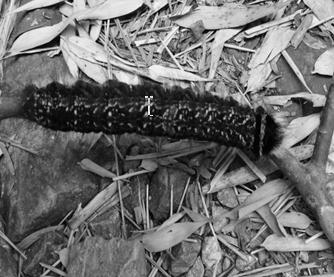Beauveria bassiana BbJL-01 with strong pathogenicity on final instar larvas of dendrolimus houi lajonquiere
A technology of Beauveria bassiana and Beauveria bassiana, which is applied in the field of agricultural biology, can solve the problems of serious damage to the last instar larvae, poor control effect and the like, and achieves the effect of good comprehensive indicators.
- Summary
- Abstract
- Description
- Claims
- Application Information
AI Technical Summary
Problems solved by technology
Method used
Image
Examples
Embodiment 1
[0030] Example 1 Isolation and identification of pathogenic fungi
[0031] 1. Test strains
[0032] The strains used in this experiment were derived from natural worms infected by Beauveria bassiana. The isolated and purified strains were inoculated on slant medium and stored in Fujian Agriculture and Forestry University’s key laboratory for the prevention and control of major pests in ecological public forests in Fujian Province. See Table 1 for sample information.
[0033] Table 1 Sample information
[0034]
[0035] 2. Determination of growth rate and sporulation of different strains
[0036] Different strains were inoculated on the center of the PDA plate by the drop method, cultured in an incubator at 25°C, and the diameter of the colony was measured once a day by the cross method, and three replicates were set for each treatment, and a total of 15 days were observed to compare the colony growth of different strains speed. At the same time, record the time when the...
Embodiment 2
[0055] 1. Toxicity determination
[0056] The isolated Beauveria bassiana strains were respectively transferred to PDA medium and cultured at a constant temperature of 25°C. After 10 days, the spores were collected, and a certain amount of spores were scraped from the plates of each strain, placed in sterilized 0.1% Tween-80 sterile water, and 1.0 × 10 7 For the spore suspension, use 0.1% Tween-80 sterile water as a control. Soak the 7th instar larvae of the cedar caterpillar in the prepared spore suspension for 10 seconds, absorb excess water with filter paper, then put the larvae into a jar with cedar branches, seal it with gauze, and place it in an incubator ( 25°C, RH 90%, L:D=14 h:10 h). 15 last-instar larvae were treated, and 3 repetitions were performed. image 3 It is a picture of the last instar larva of the cedar caterpillar in normal state; Figure 4 It is the infection symptom map after the last instar larvae of the cedar caterpillar are infected with Beauveria...
PUM
 Login to View More
Login to View More Abstract
Description
Claims
Application Information
 Login to View More
Login to View More - R&D
- Intellectual Property
- Life Sciences
- Materials
- Tech Scout
- Unparalleled Data Quality
- Higher Quality Content
- 60% Fewer Hallucinations
Browse by: Latest US Patents, China's latest patents, Technical Efficacy Thesaurus, Application Domain, Technology Topic, Popular Technical Reports.
© 2025 PatSnap. All rights reserved.Legal|Privacy policy|Modern Slavery Act Transparency Statement|Sitemap|About US| Contact US: help@patsnap.com



